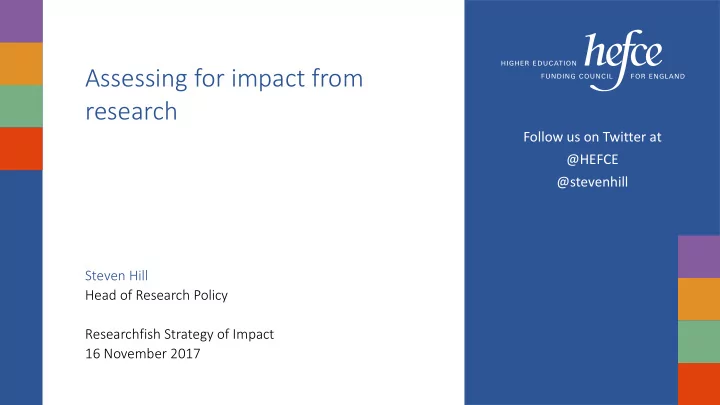

Assessing for impact from research Follow us on Twitter at @HEFCE @stevenhill Steven Hill Head of Research Policy Researchfish Strategy of Impact 16 November 2017
Measurement, assessment and evaluation of research impact is an increasing area of activity within universities. This has largely been driven by externally imposed summative assessment processes. There are opportunities to use the evidence that is being collected for different purposes: to understand the processes of research, knowledge exchange and impact in near real-time and use that insight to make adjustments to maximise impact. To achieve this we need to focus on improving real-time evidence capture, data-linking and interoperability. Closed datasets are a potential barrier to this.
Why assess research impact? Advocacy Accountability Analysis Allocation Morgan Jones M and Grant J (2013) Making the grade: methodologies for assessing and evidencing research impact. Dean et al. (Eds) (2013) 7 Essays on Impact. DESCRIBE Project Report for Jisc. University of Exeter. https://www.exeter.ac.uk/media/universityofexeter/research/ourresearchexcellence/describeproject/pdfs/2013_06_04_7_Essays_on_Impact_FINAL.pdf
Advocacy Accountability 160.0 2014-15 total QR funding (£M) 140.0 120.0 Analysis Allocation 100.0 80.0 60.0 40.0 20.0 0.0 English Universities in receipt of QR
Advocacy Accountability 160.0 2014-15 total QR funding (£M) 140.0 120.0 Analysis Allocation 100.0 80.0 60.0 40.0 20.0 0.0 English Universities in receipt of QR
Advocacy Accountability Analysis Allocation
Advocacy Accountability Analysis Allocation
Research, knowledge exchange and impact Academic impacts processes Inputs People Infrastructure Knowledge Money Societal impacts Evaluation Evidence Outcomes database Impact Case Study
Research, knowledge exchange and impact Academic impacts processes Inputs People Infrastructure Knowledge Money Societal impacts Evaluation Near real-time feedback Evidence
Why assess research impact? Advocacy Accountability Adjustment Analysis Allocation Morgan Jones M and Grant J (2013) Making the grade: methodologies for assessing and evidencing research impact. Dean et al. (Eds) (2013) 7 Essays on Impact. DESCRIBE Project Report for Jisc. University of Exeter. https://www.exeter.ac.uk/media/universityofexeter/research/ourresearchexcellence/describeproject/pdfs/2013_06_04_7_Essays_on_Impact_FINAL.pdf
Impact assessment for adjustment needs… • Near real-time data collection and analysis
https://theodi.org/blog/where-are-the-uks-most-active-tech-innovation-cities http://www.picklejarcommunications.com/wp-content/uploads/2017/11/Full- map-with-labels.pdf
Impact assessment for adjustment needs… • Near real-time data collection and analysis • Better linking of data sources
Research, knowledge exchange and impact Academic impacts processes Inputs People Infrastructure Knowledge Money Societal impacts Evaluation Evidence Outcomes database Impact Case Study
Health and life sciences Physical sciences and engineering Social Sciences Arts and 2206 links between funded research humanities projects and impact case studies
Impact assessment for adjustment needs… • Near real-time data collection and analysis • Better linking of data sources • Inter-operability and open data
Measurement, assessment and evaluation of research impact is an increasing area of activity within universities. This has largely been driven by externally imposed summative assessment processes. There are opportunities to use the evidence that is being collected for different purposes: to understand the processes of research, knowledge exchange and impact in near real-time and use that insight to make adjustments to maximise impact. To achieve this we need to focus on improving real-time evidence capture, data-linking and interoperability. Closed datasets are a potential barrier to this.
Recommend
More recommend